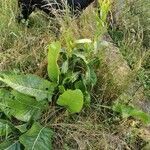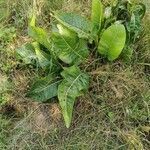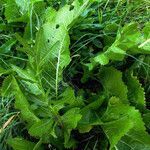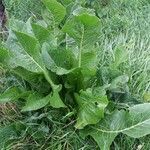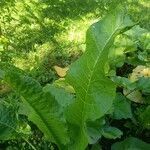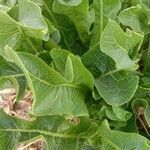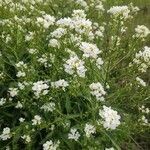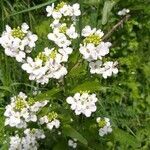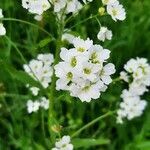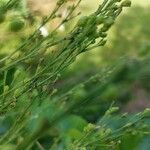Roots fusiform or cylindrical, fleshy or woody. Stems 5-12 (-20) dm. Basal leaves: petiole to 60 cm (broadly expanded basally); blade broadly oblong, oblong-lanceolate, or ovate, (10-)20-45(-60) cm × (30-)50-120(-170) mm, margins usually coarsely crenate, rarely pinnatifid. Cauline leaves: proximal shortly petiolate, blade oblong to linear-oblong (lobed), smaller than basal, margins pinnatifid or pinnatisect; distal sessile or shortly petiolate, blade linear to linear-lanceolate, base cuneate or attenuate, margins usually serrate or crenate, rarely entire. Racemes to 40 cm. Fruiting pedicels ascending, 8-20 mm. Flowers: sepals 2-4 mm; petals obovate or oblanceolate, 5-7 (-8) mm, claw to 1.5 mm; filaments 1-2.5 mm; anthers 0.5-0.8 mm. Fruits (rarely produced), 4-6 mm; style obsolete or to 0.5 mm; stigma well-developed. Seeds compressed (often not produced, rarely to 4 per locule). 2n = 32.
Perennial arising from stout white fusiform roots. Stems stout, erect, grooved, branched above, to 130 cm tall. Rosette lvs elliptic to ovate to oblong, crenate or serrate; lamina (5)-10-30-(50) × 4-10-(15) cm; petiole 5-20-(50) cm long. Lower stem lvs similar in size and outline, but often deeply pinnatifid; upper stem lvs sessile, linear-lanceolate, toothed or entire, 4-12-(20) × 0.5-1-(3) cm. Panicle to 35 cm long; lateral axillary racemes to 20 cm long. Sepals 2-3 × 1-1.5 mm. Petals 4-5 ×2 mm. Silicle abortive, narrow-cylindric, 2-3 mm long.
Erect perennial to 1 m from thick roots; lower lvs long-petioled, the blade oblong, 1–3 dm, cordate at base; upper lvs smaller, short-petioled to sessile, lanceolate; racemes several, terminal and from the upper axils; pet 6–8 mm; mature pedicels ascending, 8–12 mm; frs obovoid, bilocular, to 6 mm, or falling early; style 0.3 mm, with broad, persistent stigma; seeds rarely maturing; 2n=32. Native of se. Europe and w. Asia; commonly cult. and widely escaped into moist soil. May–July. (A. armoracia; A. lapathifolia; Radicula armoracia)
Sep ascending, elliptic to obovate; pet white, obovate, gradually narrowed to the claw; short stamens subtended by a U-shaped gland; long stamens subtended by a small conic gland; anthers linear-oblong; ovary ovoid to ellipsoid; ovules numerous; style slender, stigma large, capitate; frs inflated, obovoid or ellipsoid, tipped with the slender style and conspicuous stigma; valves with an inconspicuous midnerve, otherwise nerveless; glabrous herbs. 4, Europe to Siberia.
A cabbage family herb. It has stems up to 120 cm tall. It has fleshy roots. They are parsnip like with a spicy, bitter flavour. The taproot is 30 cm long and has smaller side roots. The roots are hairy and wrinkled and have a yellowish-brown skin. The flesh inside is white. The plant keeps growing from year to year. The leaves are 60 cm long. The flowers are small and have a smell. The fruit are oblong wrinkled pods. Usually the seeds do not grow.
